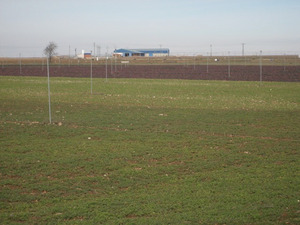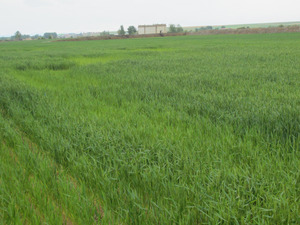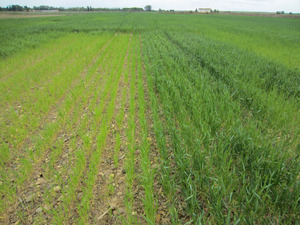Farmer network for improving nitrogen and water efficiency, Spain



The Universidad Politécnica de Madrid (UPM) set up a bread wheat network in collaboration with conventional arable farmers, advisors and a regional organization specializing in providing extension service and recommendations to farmers (ITAGRA) to improve nitrogen and water use efficiencies at a crop and cropping system level.
The network tested different genotypes of bread wheat in combination with innovative farm approaches in on-farm trials with 6 farmers (4 over all trial years). A kick-off meeting took place in November 2017 to collect opinions about the main challenges to production and to identify strategies to test in the on-farm trials. In our meeting, a common theme was seasonal droughts as the main limitation to production in the region and water availability is the main factor determining yield. As a consequence, potential yield and wheat nitrogen requirements vary among years and adjusting nitrogen application to crop demand is a challenge. In addition, in this region the legumes that were usually included in the crop rotation were replaced by other crops due to a lack of profitability in the last 20 years. Regional programs are promoting the reintroduction of legumes as part of climate-smart agriculture and as a way to increase sustainability. Along these lines, the SolACE project conducted on-farm trials to test if new bread wheat genotypes have the ability to better use the nitrogen left by legumes, and to increase yield resilience under the variable water availability conditions.
A further consideration was if the lower legume profitability could be compensated for by fertilizer savings and an improved wheat response. Therefore, introduction of legumes was combined in the trials with reduced nitrogen fertilizer rates and the use of decision support tools (optical sensors) to ensure fertilizer saving in the wheat following the legume.
The farmer network is located in Northwestern Spain (Castilla-León Region). The area is characterized by a sub-humid Mediterranean climate with 450-700 mm average annual precipitation that periodically suffers long droughts. In dry years, water allocated to irrigation may be drastically reduced and potential yields, which are usually high under irrigated conditions, significantly decrease.
Loam soils are common, with a pH of more than 7.5 and medium organic matter content. Soils are deep and with a high to medium water holding capacity, and are therefore, very suitable to test the ability of wheat genotypes to increase water and nitrogen use efficiency.
The network consists of arable farms with bread wheat in 2 or 3-year crop rotations. The farms are either rainfed or irrigated with conventional fertilizer management. In rain fed farms, a common rotation is barley/wheat/rapeseed that could be compared to legume/wheat/rapeseed. Sometimes the rapeseed is substituted by sunflower. In irrigated farms, summer crops are introduced (maize and sugar beet mainly) but there is also wheat/wheat monoculture that could be compared to a legume/wheat rotation. Common legumes in the region are grain for human consumption (lentils, peas, garbanzo peas, etc.) or fodder for animal feeding (vetch and alfalfa). Previous collaborations took place with ITAGRA and some of the farmers in fertilizer trials, as well as the use of sensors (see images), which ensured a solid foundation for this network.
 tap and then scroll down to the Add to Home Screen command.
tap and then scroll down to the Add to Home Screen command.